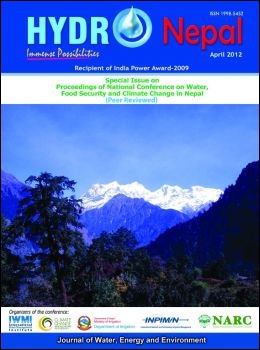Hydrology of South Asia from the Perspective of Global Environmental Changes
DOI:
https://doi.org/10.3126/hn.v11i1.7196Keywords:
South Asia, water resources, climate change, environmental change, precipitationAbstract
On average, South Asian river basins drain about 2,672 km3 of water to the oceans every year, which is almost 6% of the global runoff. These rivers also contribute 15% to 20% of the global oceanward sediment flux. Retreating glaciers and decreasing flows during low flow seasons have already shown the signatures of global warming in the region. Temperature trends in the South Asian region range from -2.9°C per decade to +4.0°C per decade. Similarly, precipitation changes fall in the range of -8% to +18% during the period of available records. One of the major concerns regarding climatic change in the region is the tendency of decreasing low flows in several major river basins. Such alterations in river discharge may cause adverse impacts on available water supplies during critical periods. Besides, the region is subjected to high vulnerabilities of water resources because of population pressure, poverty and agriculture-based economy, strong temporal and spatial variation of precipitation, and significant spatial variations of geological parameters. The management of water resources needs to consider the integrated impacts of demographic, land-use, and climatic changes in an integrated manner.
DOI: http://dx.doi.org/10.3126/hn.v11i1.7196
Hydro Nepal Special Issue: Conference Proceedings 2012 pp.7-11
Downloads
Downloads
Published
How to Cite
Issue
Section
License
The copyright of the articles and papers published is held by HYDRO Nepal Journal.
The views and interpretation in this journal are those of author(s), and HYDRO Nepal does not bear any responsibility for the views expressed by authors in the journal.




